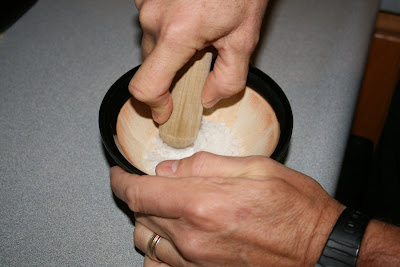 The DH and I took a class on lactofermentation and we recently made our own sauerkraut, the old-fashioned way. Lactofermentation uses no heat. It relies on naturally-present bacteria to break down the food and provide probiotics. Lactofermented foods are good for you like yogurt and other "live" foods. The kraut tastes tangy, slightly salty, and is such a pretty color! I've seen red cabbage used, as well, for a lovely pink hue. Next up, I hope to make some kimchi and try kombucha.
The DH and I took a class on lactofermentation and we recently made our own sauerkraut, the old-fashioned way. Lactofermentation uses no heat. It relies on naturally-present bacteria to break down the food and provide probiotics. Lactofermented foods are good for you like yogurt and other "live" foods. The kraut tastes tangy, slightly salty, and is such a pretty color! I've seen red cabbage used, as well, for a lovely pink hue. Next up, I hope to make some kimchi and try kombucha.Below I share our general process of making sauerkraut. These steps are meant to be informative, but not instructional. If you want to try this, find yourself a good book. I suggest Wild Fermentation by Katz.
Step 1: Grate the cabbage. We have a handy-dandy hand-crank tool that makes fast work of this. We used nearly an entire head of cabbage.

Step 2: Crush the salt, if it's not in small particles. It's important to use natural salts that don't have additives. (Hand modeling by the DH.) We used 2 tablespoons of salt. The recipe called for between 1 and two tablespoons. Next time, I'll use a bit less.
Step 3: Toss in the salt, and "tamp" the cabbage. Yes, tamp is a technical term. It means beat the heck out of the stuff. You can see here we are using a pasta measuring device for its flat bottom. Tamping starts the cabbage along its journey, and in combination with the salt, releases the juices. Tamp until the cabbage looks shiny, or lightly cooked.
Step 4: Place into jars (or, traditionally, a crock) and tamp some more. You need to ensure all the cabbage is below a layer of juice.





13 comments:
oh wow....i need to talk to you about this...my mother would love it...she is german :) and her mother used to make it....it would be a great surprise for her ....thanks!!!!!
How fascinating! (I LOVE sauerkraut ... a Reuben sandwich, yum!)
I just purchased Wild Fermentation for my daughter for Christmas. I tried making sauerkraut years ago in a crock. Oh my the smell about killed us, I think it went bad and I had to dump it. You are tempting me to try again.
Hi, Marilyn! We didn't notice any strong smells, so I agree that your batch may have been off.
Ooooh, my mouth is watering and the back of my throat is getting that tart twanging tingle in it!(You all know what I'm talking about) I do love kraut!
Steph, I love kombucha. I haven't tried making it myself yet, but plan to in 2009.
I really think its the miracle drink!
Oooh! I've always wanted to make homemade sauerkraut. Did you like the finished product?
I've had kombucha a few times; I can't say it's my favorite thing ever, but it is kinda interesting.
WOW what an interesting class to take. I have never heard of one offered around here. HA!
I do remember though being at my Dad's in Illinois as a child and a neighbor was making kraut and putting it in the HUGE crock.
Hailing from the Midwest orginally we love kraut....unlike most people here.
And we love RUBENS too..in fact I had a fabulous one for lunch last Saturday.
When your father was in the service and was in Korea, he talked about the Kimchi that was made there. It will be interesting to see what you come up with. He wasn't to impressed with the taste of it.
Love,
Mom
oh yum!my husband loves this!
Makes me think of my grandmother. She was from Poland and was a great cook. She used to make a dish with sauerkraut, onion, kielbasa and whole allspice that was so good. It was a cooked dish and so I guess most of the health benefits would be lost.
From the above post:
"Lactofermentation uses no heat. It relies on yeasts in the air to break down the food and provide probiotics. Lactofermented foods are good for you in the same manner as yogurt and other "live" foods."
Some basic factual errors here.
Lactofermentation does not use *yeasts*; it uses bacteria.
The bacteria are not from the air; they're in the food itself.
Yogurt *is* a lactofermented food.
Thanks for your input. Would love to know who you are, so I can learn more from you about this.
Post a Comment